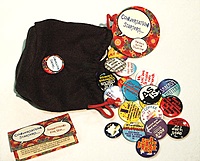THIAGI GAMELETTER:
January 2011
SERIOUSLY FUN ACTIVITIES FOR TRAINERS, FACILITATORS,
PERFORMANCE CONSULTANTS, AND MANAGERS.
TABLE OF CONTENTS
Masthead
Our mission statement, copyright notice, and cast
of characters.
In Memorium
Mike Doctoroff, 1934-2010
A playful spirit passes away.
Training
A Tale of Two Cultures
The times are changing.
Interactive Storytelling
Chapters
Let the participants create the case.
Guest Gamer
An Interview with Gauthier de Pierpont
The adventure goes on.
Improv
Cross the Circle by
Tracy Tagliati
Finding similarities.
Say It Quick
First Amendment by
Brian Remer
Playing hit and run with social
issues.
Discoveries
Conversation Starters: Pin-Back Button Collection by
Brian Remer
Engaging in substantial
conversations.
Ideas
21st Century Skills: An Interview with Jennifer
Stanchfield by
Brian Remer
A participant-centered experiential
educator.
Activities
Ships that Pass in the Night by
Brian Remer
What buttons do you choose?
Dallas Workshops
Interactive Techniques for Instructor-Led
Training by
Tracy Tagliati
Public workshops in the USA.
Zurich Workshops
Thiagi and Sam in Zurich
Public workshops in Europe.
Single Topic Survey
Humor at Work by
Tracy Tagliati
A laughing matter.
Survey Results
Looking Back on 2010 by
Tracy Tagliati
A summary of your responses.
Check It Out
Online Video Series About Teaching Online
27 videos to learn from.
Masthead
THIAGI GAMELETTER:
SERIOUSLY FUN ACTIVITIES FOR TRAINERS, FACILITATORS,
PERFORMANCE CONSULTANTS, AND MANAGERS.
Mission
To increase and improve the use of interactive,
experiential strategies to improve human performance in an
effective, efficient, and enjoyable way.
Editorial Roster
 Author and Editor
: Sivasailam (Thiagi) Thiagarajan
Author and Editor
: Sivasailam (Thiagi) Thiagarajan
 Assistant Editor
: Raja Thiagarajan
Assistant Editor
: Raja Thiagarajan
Associate Editors: Jean Reese and Tracy Tagliati
Contributing Editors: Brian Remer and Matthew Richter
Editorial Advisory Board: Bill Wake, Matthew Richter, Samuel van den Bergh, and <type your name here>
Copyright Info
The materials in this newsletter are copyright 2011 by The
Thiagi Group. However, they may be freely reproduced for
educational/training activities. There is no need to obtain
special permission for such use as long as you do not
reproduce more than 100 copies per year. Please
include the following statement on all reproductions:
Reprinted from THIAGI GAMELETTER. Copyright © 2011
by The Thiagi Group, Inc.
For any other use of the content, please contact us (
thiagi@thiagi.com ) for permission.
Subscription Info
To sign up, or to donate and help us continue this
newsletter, please see the Online
Newsletter page on our website (
http://thiagi.com/pfp.html ).
Feedback Request
Thiagi believes in practicing what he preaches. This is an
interactive newsletter, so interact already! Send us your
feedback, sarcastic remarks, and gratuitous advice through
email to thiagi@thiagi.com . Thanks!
[Table of
Contents]
In Memorium
Mike Doctoroff, 1934-2010

One of our wonderful friends, Mike Doctoroff, founder and
chairman of Trainers Warehouse, passed away December 1, 2010
after a long battle with ALS.
Mike was a genial, creative, and playful person. He invented,
produced, collected, and distributed several tools for
trainers that made their sessions more engaging and enjoyable.
He founded and developed a retail distribution organization
that has become the single source for all types of effective
training resources.
I had the pleasure of talking with Mike about his ideas and
plans.
Our condolences to Mike's wife Honey, his daughter Sue, and
the rest of his family. I have no doubt that they will carry
on Mike's tradition and core values and continue to fulfill
his mission.
[Table of
Contents]
Training
A Tale of Two Cultures
Let's compare the training of adults in two different
cultures. For the present, let's call them Culture A and
Culture B. Later, you can figure out where these two cultures
are located.
Cast of Characters
In Culture A, the trainer is responsible for
making learning happen because participants don't
have sufficient knowledge or experience to decide what they
should learn. After all, adult participants are children
with big bodies. Good participants are eager to listen, take
notes, and accept everything the trainer says. They do not
disturb other participants (and the trainer) by asking silly
questions. They wait patiently, because the trainer will
explain everything to them at the appropriate time.
Effective trainers are experts in their subject area. They
focus on what is good for most participants without wasting
time and effort to accommodate the slower or smarter
ones.
In Culture B, participants assume total
responsibility for their own learning. They take a major
role in determining what they should learn and how they
should learn it. The facilitator guides the
participants' learning process by providing access to
different sources of expert content. Effective facilitators
are experts in structuring the learning process, making it
interactive, and encouraging participants to learn
collaboratively.
Training Content
In Culture A, the trainer derives the instructional
objectives by analyzing the content area, using his or her
expert knowledge. The trainer also decides what, when, and
how the content should be presented to the participants.
Generally, the trainer uses a deductive approach by
explaining the rules and principles first and then
describing specific applications in a logical order. The
trainer sticks to facts and expert opinions because there is
no room in a lesson for emotions and feelings. Effective
trainers do not deviate from their lesson plans even in the
face of tangential questions from participants. It may be
true that some learners have different experiences, entry
points, and personal agendas. But these differences are
irrelevant because the trainer knows what everyone needs to
learn.
In Culture B, the facilitator works with a few typical
participants to outline the session in terms of appropriate,
participant-centered activities. The training goals are
selected to meet the needs of participants. The activities
are sequenced to facilitate the processing of content and
discovery of principles. The original outline is modified by
the facilitator (and sometimes totally abandoned) in
response to participant's questions and reactions.
Training Activities
In Culture A, the trainer takes on the role of a sage on
the stage and presents the content through explanations and
demonstrations, using a chalkboard or a flip chart.
Participants take notes and supplement the lectures by
reading assigned sections in their textbook.
In Culture B, the facilitator takes on the role of a guide
by the side and conducts a variety of learning activities
that incorporate hands-on experience and invite interaction
among participants. The facilitator may use reading
assignments and lecture presentations, but they are always
followed by interactive exercises that encourage
participants to explore, evaluate, analyze, synthesize, and
apply the content to their workplace context.
Training Environment
In Culture A, the classroom is formally organized to focus
on the trainer and to make it easy for the participants to
listen to the lecture and to observe the demonstration. The
classroom is also designed to prevent distractions from
other participants and from the outside world. The furniture
requires participants to sit up straight and to take
notes.
In Culture B, the training room is informally arranged to
facilitate interaction among participants. The furniture
typically consists of round tables with chairs around them.
However, participants are frequently on their feet, roaming
around the room and interacting with each other. The walls
of the training room are plastered with posters, many of
which are created by the participants themselves.
Training Assessment
In Culture A, participants take a final written test that
measures their ability to recall the content from the
lectures and textbooks. The trainer scores participant
responses and awards grades, making sure that participants
are spread along a bell-shaped curve. Test scores are used
to determine who should be certified and who should
fail.
In Culture B, numerous participant activities enable them
to constantly check their mastery of the training objectives
and their ability to apply them to different situations.
Participants receive immediate and specific feedback from
their peers and from the facilitator. This type of
performance-based feedback improves individual performance
and the overall effectiveness of the training
activities.
Where Are These Cultures?
Later this year, Tracy and I will be facilitating a summer
institute on interactive strategies for multicultural
communication. Eleven summers ago, when I first offered this
institute, participants had no difficulty identifying
Culture B as U.S.-American (along with Canada, England,
Australia, Holland, Denmark, and Sweden) and Culture A as
the rest of the world, which includes 85 percent of the
population. These participants also considered it elitist
and colonial for U.S. trainers to impose their Culture B
training approaches to Culture A countries. Last year, in
Zurich and Singapore and Paris, participants from 12
different countries found that the training scene is no
longer black and white. Some reported the increasing use of
interactive, experiential strategies in European and Asian
countries that traditionally belonged to Culture A. At the
same time, others reported increasing demands for passive
procedures among Culture B countries, especially in
technical training areas. In addition, most participants
found it difficult to identify exclusive application of
training techniques associated with either culture. The new
group of trainers seems to favor their own blended
combinations.
The times are changing—along with cultural
perspectives and preferences related to teaching and
learning. There is no single best method. As a flexible
facilitator, it is important for us to have available a wide
variety of training strategies so that we can pick and
choose the best combination that fits the cultural context,
participant preferences, and content requirements.
[Table of
Contents]
Interactive Storytelling
Chapters
Purpose
To identify the steps in the basic needs analysis process
and to apply them to a simulated project.
Participants
Any number can play. This activity works best with 12 to 30
participants.
Time
30 to 45 minutes
Supplies
Copies of Needs
Analysis, a handout that explains the need
analysis process.
Copies of How We Figured Out
How To Double Our Monthly Income, a case
that illustrates specific application of the process.
Preparation
Master the model. Your success in using
this activity format will depend on your fluency with the
basic needs analysis model. Carefully study the handout that
explains the process. Figure out what is happening in each
step and how the steps are linked to each other.
Create a story. The best way to master the
model is to make up a fictional case that illustrates the
application of the needs analysis process. This is what you
will be asking the participants to do, and you need a sample
story to prime them. Review the case study to figure out the
plot line for your story. You can base your story on one of
your own successful projects. If you do so, don't let facts
get in the way of a good story that clearly tracks your
progress through the needs analysis steps. If you are
adventurous, create a story around some popular TV show. If
you are fainthearted, plagiarize the case from the
handout.
Flow
Brief the participants. Using your own
words, present some introductory comments about the basic
needs analysis process. Here are some key points that you
may want to include in your presentation:
Needs analysis is the essential first step in applying
human performance technology to solve performance
problems. It is also the first step in the instructional
design process.
By applying this systematic process, you avoid solving a
wrong problem or a trivial problem. You also avoid solving
the right problem with a wrong technique.
Needs analysis involves clearly defining a performance
problem as a gap between what you want to happen and what
is actually happening, finding reasons for this gap, and
closing them with an appropriate intervention.
Distribute the handout that explains the needs
analysis process. Point out that the handout
identifies the steps in the process and the relationships
among them. Ask the participants to read and review the
handout. Announce a 3-minute time limit for this
activity.
Tell your story. At the end of the time
limit, announce that you are going to tell a story of the
needs analysis process in action to make the abstract model
become concrete. Narrate your story, pausing at the end of
each “chapter” to refer to the steps in the
process.
Distribute the case. Explain that this
case study illustrates the application of the needs analysis
process. Suggest that the participants refer to this case
study later—after you give them an assignment.
Assign the story-creation task. Divide the
participants into teams of three to five members each. It
does not matter if some teams have an extra member. Ask each
team to begin creating a fictional case study of a
successful application of the needs analysis process. The
first chapter of the story should clearly illustrate the
application of the first step (Identify the ideal
performance). The teams have 3 minutes to create
the first chapter.
Invite a team to present its first
chapter. Give the teams a 1-minute warning. Ask
the teams to give finishing touches to the chapter. After
another minute, randomly choose a team to send its
storyteller to the front of the room. Ask this person to
present the first chapter.
Add the second chapter. At the conclusion
of the presentation, ask all teams to continue the story
they heard by writing the second chapter. Apologize to the
members of the other teams. Explain that you are going to
ignore the first chapter they had created earlier. Make sure
that the teams understand that they are to create the second
chapter to continue the first chapter they heard. Explain at
the end of the 3-minute time limit, you will randomly select
a team (that could even be the team that read its first
chapter) and hear the second chapter.
Continue the story writing activity, one chapter at
a time. After 3 minutes, select another team and
have them read the second chapter. Ask the teams to create
the third chapter to continue the ongoing case study. Repeat
this process with all teams writing the ensuing chapters and
the chapter from one random team being added to the
continuing case study.
Conclude with a caveat. At the end of the
sixth chapter, congratulate the teams on their depth of
understanding of the needs analysis process. However, point
out the inherent danger in using a mechanical, step-by-step
process. Warn the participants against rigid, obsessive use
of the needs analysis steps.
[Table of
Contents]
Handout1
Needs Analysis
Needs analysis is the process of identifying a suitable
solution to a performance problem. You do this by specifying
the problem as a gap between the ideal state and actual state,
discovering the causes of this gap, and selecting a suitable
intervention to remove (or reduce) these causes.
The need analysis process consists of the following six
steps:
Step 1. Identify the ideal state
Interview the client and other stakeholders (such as the
members of the work team, managers, and customers) to
specify the desired performance of typical employees that
will produce the results they would like to see. This level
of performance is known as performance to standard or the
ideal performance.
Step 2. Identify the actual state
Interview the client and other stakeholders to specify the
current level of performance of typical employees. Validate
this actual performance level by observing the employees,
conducting surveys, and analyzing existing records.
Step 3. Specify the performance gap
Use the information collected in the earlier steps to
define the performance problem as the difference between the
ideal and the actual state. Whenever possible, convert both
the ideal state and the actual state to the same units of
measurement, and define the gap in specific quantitative
terms.
Step 4. Identify possible causes
Continue with additional interviews and other data
collection strategies to discover the probable causes for
the gap between the ideal and actual states.
Step 5. Identify the root cause
Analyze the probable causes identified in the previous step
and organize them into suitable categories (such as lack of
skills, lack of motivation, or lack of tools). Through
additional analysis and interviews with different
stakeholders, narrow the causes to one (or two) root cause
that, if removed, will narrow the performance gap.
Step 6. Identify suitable intervention
Review the performance gap and its root cause. Select a
suitable intervention: a strategy that removes or reduces
the gap by removing the root cause.
[Table of
Contents]
Handout2
How We Figured Out How To Double Our Monthly
Income
Chapter I. The Ideal State
I am the CEO of a small company with four employees and a
couple of freelance associates. Among the other job
responsibilities that I have, I act as a performance
technologist in my company.
One day in September, in one of our staff meetings,
somebody asked, “When are we going to get a pay
raise?”
This was a silly question because we were having
difficulties even in meeting our current payroll. After
laughing at this question, we decided to take it seriously
and use it as a trigger for conducting a needs analysis.
I asked the folks to begin at the beginning and suggest the
ideal state. Here are different ideas that were offered:
Give everyone a 20 percent pay raise.
Make more money every month.
Get a bank loan and pay people more money every
month.
We decided that most of these ideas did not incorporate
SMART objectives. Eventually, we decided to stick with this
statement of the ideal state:
Make $50,000 every month.
This amount should enable us to give everyone a 10 percent
pay raise and meet our monthly payroll without any
difficulty.
Chapter II. The Actual State
We knew that we had difficulty making our monthly payroll
frequently. But we did not have any idea on how much money
we were making each month. Different people came up with
different estimates and they varied significantly. Even our
bookkeeper was clueless about our monthly income. When
confronted, he mumbled something about wide variances in our
earnings and the differences among accruals, receivables,
cash flow, and so on. We asked him to get some solid data
and report to us during the next meeting. We threatened to
fire him if he did not have accurate and up-to-date
data.
At the next meeting, our bookkeeper did bring some credible
data in the form of a spreadsheet. The bad news was clear
for all of us to see: We made an average of $23,487 during
the past 8 months. The predicted income for the next 4
months did not appear to be significantly different.
Chapter III. The Performance Gap
The performance gap was easy to figure out:
Ideal state: $50,000
Actual state: $23,487
Gap: $50,000 - $23,487 = $26,513
Chapter IV. Possible Causes
We asked ourselves the question, “Why are we not earning
as much as we should every month?”
There were a lot of wild speculations, and some of them had
nothing to do with the performance gap.
Here are a few of the ideas offered by everyone:
Some people are paid bloated salaries.
It's the economy, stupid.
Our clients are cheapskates.
The government is moving toward socialism.
Most clients want eLearning. We don't have a credible
track record in that area.
We are not listening to our customers.
We don't have the bells and whistles that the other
consultants flaunt.
We need a marketing person.
Eighty percent of our income comes from two major
clients.
We are not charging enough. Look at Tom Peters. He
charges $20,000 for each keynote speech he delivers.
We should develop and sell products. We have reached our
capacity in providing consultation and conducting
instructor-led workshops.
Chapter V. The Root Cause
After a lot of discussion about the possible causes and
yelling at each other, we settled down to this statement of
the root cause:
We are not marketing our products and services.
Chapter VI. The Intervention
After talking about the cause behind the root cause, we
figured out that we lack sufficient capacity to handle the
demands of marketing. So our intervention was to hire a
hot-shot marketer.
Chapter VII. Epilogue
We had a clear idea of the intervention but we were caught
in a Catch-22: We cannot hire a marketing person unless we
make more money and we cannot make more money unless we hire
a marketing person. So we are still continuing our business
as usual, mumbling philosophical inanities like, “Money is
not everything.”
[Table of
Contents]
Guest Gamer
 Gauthier de Pierpont has
been working in business theatre for more than 15 years as a
scriptwriter and improv actor. One day, when asked to a
training workshop in public speaking, he borrowed principles
and procedures from his background to create a highly
interactive design, based on improv exercises. This got him
started off as a trainer. Very soon, his toolkit expanded to
include eclosive pedagogy from Andre Coenraets in Belgium (
http://www.cefar.org/ ) and framegames from
Thiagi. Eclosive pedagogy is based on the idea that the
knowledge is within the participant and that the facilitator
has to create the proper structure to let it emerge!
Gauthier's playful and creative mind combined it with the
Thiagi philosophy. Creating, developing, and facilitating
games became the most engaging part in his training
business. Now for more than 10 years, he's been designing
made-to-measure programs on interpersonal skills. Games he's
designed include Chinese Torture
Jolt, Hurdle of
Gratitude, Ten Commandments Team
Game, Emotional
Hundred, Psychic Debrief.
These games are not yet well known, since his book is still
to be published. Currently, he conducts workshops in Belgium
and has launched a new project, Whats-Up?, an
event company specializing in tree climbing and teambuilding
events.
Gauthier de Pierpont has
been working in business theatre for more than 15 years as a
scriptwriter and improv actor. One day, when asked to a
training workshop in public speaking, he borrowed principles
and procedures from his background to create a highly
interactive design, based on improv exercises. This got him
started off as a trainer. Very soon, his toolkit expanded to
include eclosive pedagogy from Andre Coenraets in Belgium (
http://www.cefar.org/ ) and framegames from
Thiagi. Eclosive pedagogy is based on the idea that the
knowledge is within the participant and that the facilitator
has to create the proper structure to let it emerge!
Gauthier's playful and creative mind combined it with the
Thiagi philosophy. Creating, developing, and facilitating
games became the most engaging part in his training
business. Now for more than 10 years, he's been designing
made-to-measure programs on interpersonal skills. Games he's
designed include Chinese Torture
Jolt, Hurdle of
Gratitude, Ten Commandments Team
Game, Emotional
Hundred, Psychic Debrief.
These games are not yet well known, since his book is still
to be published. Currently, he conducts workshops in Belgium
and has launched a new project, Whats-Up?, an
event company specializing in tree climbing and teambuilding
events.
An Interview with Gauthier de Pierpont
TGL: Gauthier, what is your specialty
area?
Gauthier: My favorite areas are
communication, interpersonal relations, and team dynamics. I
love jolts that make people experience a direct emotion and
require them to handle their relationships. I'm always amazed
by the fact that we, the human beings, have been taking
interpersonal communication for granted.
TGL: How did you get into designing and using
games?
Gauthier: Having no specific background as a
trainer and my being too lazy to prepare slides and write
handouts led me to taking short cuts. Discovering the concept
of framegames in 2003 gave me the necessary tools to design
interactive training.
TGL: How long have you been designing and
using games?
Gauthier: 10 years.
TGL: How do your clients respond to the use
of games in training?
Gauthier: They welcome the idea, but still
hold on to the belief that you need an expert with a lot of
content. The correct-answer syndrome is still very strong in
Belgium. However, once the clients experience training games,
they love it.
TGL: How do your participants respond to
games?
Gauthier: Like children, they jump into it.
I'm always amazed to see how people would just do any foolish
game you offer. They go for it with confidence and pleasure.
Most of the feedback we get indicates that participants are
surprised by our style. The best feedback I ever had was,
“You didn't teach me anything, but you reminded me of
several simple things that are very important. These are
things I knew, but have been pushed back in my
memory.”
TGL: What was the most horrible or
embarrassing moment you had in conducting games?
Gauthier: Honestly, I don't know; I must have
a very selective memory that only reminds me of the good
things.
TGL: What advice do you have to newcomers
about interactive training?
Gauthier: Believe in it, have faith, or don't
do it! Trust the collective intelligence of your participants.
If you cannot, don't do it. Playing is a demanding art: as a
facilitator, your instructions have to be very clear. One word
can change the activity and the outcomes. Remember, playing is
a serious business! Really!
If you do training for the purpose of being on stage, and if
you are sure that you know what is best for the participants,
then go for politics. You'll have a much more successful
career than in training.
TGL: What types of games do you use most
frequently?
Gauthier: Physical games, team challenge
games, roleplays, simulations, and improv games. Having
recently completed Thiagi and Tracy's training in Paris, my
practice is expanding.
TGL: What is your most favorite
game?
Gauthier: Big Foot Small
Foot is one of the best games for
me.
Participants pair up and stand facing each other with the
distance of about a meter between them. The person with the
smaller feet closes her hand and makes a fist. I tell the
“Big Foot” to open the fist within 20 seconds.
Participants' reactions are great: Most of them try to force
the other person's fist to open. Others bite, offer money,
tickle, or threaten. Everyone ignores the technique of making
a simple request: “Would you please open your fist?” This
game is always followed by a great debrief.
The second one (I know you asked for only one) is the
Inspired Manager, based on the guide
and the blind person. The aim of the game is for the guide to
help a blind person navigate a route. The guide has to use
voice directions alone; the players cannot touch each other.
This basic game is already engaging. But I add a second part
with slightly different rules: One person sees, four others
are blind. The guide cannot touch her team. Team members
cannot touch anyone else. They have to navigate a twisting
route. Usually, when the guide gives instructions, the four
people walk in different directions. This is a great activity
to debrief about the ability of a manager to lead a team.
TGL: Who are your favorite game
designers?
Gauthier: Thiagi—but he needs to write
things in French.
TGL: Do you have any book
recommendations?
Gauthier: Thomas d'Ansembourg :
Qui fuis-je? Où cours-tu? À quoi
servons-nous? Vers l'interiorité
citoyenne. It's not a book about games, but it's
a book about why is it worth playing games and training
people.
TGL: What is your prediction about the future
of games?
Gauthier: In Belgium, games are going to pop
up and become popular in 5 years. It's urgently needed in this
high-pressure business world. And my future is there. That's
where I want to be: playing, having fun all day long, and
getting paid for it! What else could I ask?
[Table of
Contents]
Improv
Cross the Circle
by
Tracy Tagliati
 This activity provides a playful way for
participants to find commonalities among themselves.
This activity provides a playful way for
participants to find commonalities among themselves.
Time
5 to 10 minutes.
Flow
- Ask participants to form a circle with one person in
the middle.
- The person in the middle asks the other participants
to cross through the circle if they can answer positively
that they have, have done, or can do something in
particular. For example, the participant in the middle
might say, “Cross through the circle if you carpool to
work.”
“Cross through the circle if you have worked here more
than 5 years.”
“Cross through the circle if you can play an
instrument.”
- If the other participants can answer the question
positively they must cross the circle and find an open
spot on the other side left by someone else who also
answered the question positively.
- The participant in the middle also finds a spot left
open by some one who answered the question
positively.
- A new person is left in the middle. This person gets
to pick a new topic.
- The game continues as time allows.
[Table of
Contents]
Say It Quick
First Amendment
by
Brian Remer
How much do you really know about other people's opinions?
How deeply do you usually share about your own? This month I'd
like to explore these questions beginning with this 99-Word
Story:
First Amendment
Bumper stickers are a popular medium for sharing ideas:
free speech, self expression. People state their passions
and reveal bits of their personality, politics, and sense of
humor. Whether clever, contemplative, or caustic they invite
tailgating for curiosity's sake.
But I can't help wondering. What does a yellow ribbon mean
for her, exactly? What does a peace symbol signify for him?
The catchy phrases accelerate and disappear before one can
formulate a follow up question.
Like a TV commercial or a politician's sound bite, bumper
stickers allow us to play hit and run with important social
issues.
[Table of
Contents]
Discoveries
Conversation Starters: Pin-Back Button Collection
by
Brian Remer
 Bumper stickers,
sound bites, Facebook, Twitter, 99-Word Stories. Examples of
the quick opinion abound! And while quick is clever and may
even get the message across, it's the chance for a follow up
question that leads to an interesting encounter.
Bumper stickers,
sound bites, Facebook, Twitter, 99-Word Stories. Examples of
the quick opinion abound! And while quick is clever and may
even get the message across, it's the chance for a follow up
question that leads to an interesting encounter.
We probably let too many chances for a meaningful
conversation “drive by.” And there are probably good
reasons: being busy; wanting to avoid controversy; not
noticing an opportunity; or even reluctance to change our own
opinion.
But being able to engage in a substantive conversation helps
strengthen relationships which can lead to solid friendships,
better teamwork, increased productivity, and expanded
creativity to name just a few outcomes. That's why I like this
collection of pins with quirky quips and eyebrow-raising
comments.
Distribute them to participants in a training, meeting, or
party. Then invite people to use them to spark essential
conversations with others in the room. Each button is large
enough to attract attention but small enough that you need to
be close to read it. Close enough, too, to have a
conversation!
With buttons like…
Help! I think I'm a rock star.
I'm one epiphany short of a paradigm shift.
We can do it!
Please don't make me go to my dark side.
…you can promote important moments of sharing with a
touch of humor.
With fifty buttons in a convenient cloth bag,
Conversation Starters can be easily carried to
any event. Suggestions are included for using the set to break
the ice, make introductions, process an activity, or plan for
future action steps.
Conversation Starters are available from
Experiential Tools ( http://www.experientialtools.com/ ). Learn more
about both in the following interview with their creator,
Jennifer Stanchfield.
[Table of
Contents]
Ideas
21st Century Skills: An Interview with Jennifer
Stanchfield
by
Brian Remer
Jen Stanchfield is known for her work in helping schools and
organizations use experiential methods to promote learning and
community building. She is the creator of Conversation
Starters, and author of Tips and Tools: The Art
of Experiential Group Facilitation.

Firefly News Flash: How would you describe
yourself and your work?
Jennifer Stanchfield: I have a passion for
helping people learn from interacting with others, solving
problems, experimenting, and engaging in individual and group
reflection. I work with counselors, teachers, youth-workers,
coaches, and trainers, anyone trying to create change and
growth in people or groups. An underlying philosophy of my
work is the theory of experiential education and the idea of
being a “participant-centered” teacher or
facilitator.
FNF: How did you become interested in
experiential education?
JS: As a child my family moved around a lot
and I experienced many different schools. My first few years
of school I attended two different Montessori programs. These
experiences were in great contrast with my more "traditional"
public school classroom experiences throughout the rest of my
schooling.
In High School I took part in an adventure program that was
life changing for me. This empowering experience emphasized
the difference between my "traditional" educational
experiences in formal classroom settings and field
experiences. Through this program I gained a sense of
self-reliance and confidence, and learned communication and
problem-solving skills.
I began my college career studying special education. Then I
discovered recreational therapy and the idea of using
activities to teach and help people explore and work through
problems and practice coping skills. I ended up with a dual
major in recreational therapy and outdoor education and was
first introduced to the philosophy of experiential education
and the work of John Dewey.
As I worked professionally in the mental health and public
school settings as a recreational therapist, teacher and
challenge course facilitator I became even more interested in
the philosophy of experiential education.
I pursued a graduate degree in the field. At that point
studying the work of John Dewey and others in addition to
Taoism enriched my work as a practitioner. I am especially
excited now about the new research on the brain and learning
and how that information validates some of these ideas about
experiential education first put forward so many years
ago.
FNF: What is your favorite activity as a
facilitator?
JS: I really think beginnings and endings are
very important. I like to have a great activity to start off a
group from the moment people enter the room and then an
activity at the end of a program to “tie it all
together”. Oftentimes I use the same activity for both
purposes.
To start a group I place an assortment of objects, or
postcards, quotes, or pin-back buttons for people to choose
from as they enter the room.
Depending on the goals of the program, I might ask group
members to choose a postcard that represents their goal, or an
object (from my mini-metaphors, or a my toolbox collection)
that represents a strength they bring to the group. The
pin-back buttons and quotes are great for starting this kind
of reflective conversation.
At the end of a program it can be interesting to come back to
the introductory activity to see how the group has progressed
or how individual perspectives or goals have changed.
I like these object and image based activities for many
reasons:
- Often people find it easier to share when they can
attach their thoughts to an object or image.
- The reflection can become more metaphorically rich than
with conversation alone.
- This method is “participant centered” by putting
more control upon the learner for interpreting their
experience, feelings, or goals rather than the leader
directing and possibly inserting their own interpretation or
agenda.
- This opens up a spontaneity of experience and possibly a
deeper connection to the experience and relation to real
life.
- Recent research on the brain and learning suggests that
when people can attach thoughts or key concepts to a
metaphoric image they may retain it longer.
FNF: Describe one of your favorite ways to
lead a discussion or debrief an activity.
JS: After the group has completed a lesson or
problem-solving task, I place a whole set of the postcards,
charms or a number of objects out in front of the group. I
then ask them to choose one postcard or one object together
that best represents what they achieved as a
group.
Sometimes halfway through a program I will ask them to come
to agreement on three cards or objects that represent where
they started as a group, where they have gone so far, and
where they hope to go next.
This method builds consensus. Participants are drawn into the
task of choosing and are often unaware they are processing.
Often group members share profound insights about the group
experience as they discuss their choices to the group.
FNF: How does an experiential approach to
education fit in with public schools where the emphasis has
become more and more on achieving standardized test
scores?
JS: An experiential approach teaches what
many are calling “21st Century Skills” such as critical
thinking, problem solving, and communication.
FNF: Why do you think so many people are
quick to rely upon a lecture or PowerPoint format for their
teaching or training? What advice do you have for someone who
is hesitant to use experiential techniques in their teaching
or training?
JS: Often facilitators are afraid of losing
control of a group. They feel they need to be the
“expert”. They have difficulty trusting the group
process and worry that they might not meet program
goals.
I encourage facilitators to empower their group, to take a
step back, allowing the group members to step forward and take
more responsibility for their learning.
I encourage hesitant educators to experiment and try just a
few techniques at a time. Typically they are amazed at what
happens within a group when they take a step back from their
more directive approach and implement more experiential
methods.
Other facilitators perceive that they have to put on a big
show to engage a group. There are some very successful
charismatic “big personalities” in the training field.
People think they need to have this kind of personality to be
an effective group leader. I don't think this is true. The
most effective leader is one who embraces their own style and
learns how to harness the knowledge and energy that exists in
their group. A famous Taoist quote emphasizes the power of
this kind of leader:
A good leader inspires others with confidence; a great
leader inspires them with confidence in themselves.
FNF: If you had to go to a desert island for
your next training event, what three essential supplies would
you take with you?
JS: As much as I love "stuff" like vintage
items in my toolbox, my postcards, or charms, I think being
able to "make do" with what you have can bring opportunity in
itself. Lately I have really been enjoying activities that
involve very few props such partner handshakes or concentric
circles. So, I would try to rely on what was
there.
There must be some interesting “stuff” washed up on the
shore of a desert island!
Learn more about Jen Stanchfield and sign up for her blog
at Experiential Tools .
[Table of
Contents]
Activities
Ships that Pass in the Night
by
Brian Remer
Each of us has so many facets to our person-hood that may not
be revealed even between those who have known each other for
years. Discovering these different dimensions can help keep
long-term relationships healthy, interesting, and fun. Here's
an activity that's especially good to do with someone you know
well—or think you know well!
You and your partner each pick four pin-buttons:
- a) The one you would most like to wear,
- b) The one you would least like to wear,
- c) The one that you think best fits your partner,
and
- d) The one that you think least fits your
partner.
Spend a few minutes explaining your choices one pin at a
time. Were you surprised by any of your partner's choices for
a) or b)? How do you feel about your partner's choices for c)
and d)?
Next, what does your combined choice of buttons say about
your relationship? Do you feel you know each other well or are
there ways the two of you are like ships passing in the night?
What would you like to do more of in your relationship?
Last, agree upon one button to represent your
relationship.
If you don't have a bag of Conversation Starter buttons, get
creative! Crack open some Chinese fortune cookies or page
through the comics of the Sunday paper and choose a character
to fit your partner's personality.
If you try this activity with a colleague, friend, child, or
partner, please let me know the result (email Brian)!
[Table of
Contents]
Dallas Workshops
Interactive Techniques for Instructor-Led
Training
by
Tracy Tagliati
 Did you miss out last year? Here's your
chance to attend Thiagi's Interactive Techniques for
Instructor-Led Training Workshop. Attend the fourth day and
become a certified Thiagi trainer.
Did you miss out last year? Here's your
chance to attend Thiagi's Interactive Techniques for
Instructor-Led Training Workshop. Attend the fourth day and
become a certified Thiagi trainer.
This event sold out last year.
If you register by January 15th, you save $370 for the
3-day workshop and $125 for the 1-day certification
program.
When
March 28-30, 2011
Where
Courtyard by Marriott Dallas Central Expressway
10325
North Central Expressway
Dallas, TX 75231
USA
(214) 739-2500
Planning on staying at the hotel? We have blocked off a
limited number of rooms at a discounted rate of $99. Mention
“The Thiagi Group” to get the best price when booking
your room, or ask for our sales coordinator, Julia Wolkin. She
will take good care of you. Phone: 214-622-1013, Email:
Julia.Wolkin@marriott.com .
The 1-day certification workshop (that licenses you to
conduct this workshop) will be held on March 31, 2011 at the
same location.
If you register now, you save $370 for the 3-day workshop and
$125 for the 1-day certification program.
Here are some additional details about these workshops. You
can also download a detailed brochure (194k PDF).
Registration Fees
- 3-Day Workshop (March 28-30, 2011): $1,495
- 1-Day Certification Workshop (March 31): $495
Early Bird Discount
If you register before January 15, 2011
- 3-Day Workshop (March 28-30, 2011): $1,125 (save
$370)
- 1-Day Certification Workshop (March 31): $370 (save
$125)
Group Discount
Groups of three or more who enroll at the same time will
get a 15 percent reduction on their registration fees.
Two Easy Ways to Register
Online. Visit our online store at
thiagi.com and click on “Workshops: 2011”. (You will automatically be
given the early bird discounted fee.)
Telephone. Call (812) 332-1478.
What You Get for Your Registration Fee
3-Day ITILT Workshop
- Manual, Interactive Techniques for
Instructor-Led Training
- Manual, Simulation Games for
Instructor-Led Training
- Additional handouts
- Continental breakfast
- Two refreshment breaks
- Certificate of Accomplishment
- Access to Thiagi's web site
- One-year subscription to the Thiagi
GameLetter
1-Day Certification Workshop
- Book, Framegames by
Thiagi
- Book, Simulation Games by
Thiagi
- Additional handouts
- CD-ROM with Handout Masters
- Set of slides
- Licensing Agreement
- Access to Thiagi's web site
- One-year subscription to the Thiagi
GameLetter
- Listing on Thiagi's website as a certified
trainer
- Discount on Thiagi's books and games for use in your
workshops
- Certificate of Accomplishment
More Information
For more information, please download our detailed brochure (194K PDF)
[Table of
Contents]
Zurich Workshops
Thiagi and Sam in Zurich
 Van den
Bergh Thiagi Associates are happy to offer their tenth annual
workshops in Winterthur, Switzerland (near Zurich).
Van den
Bergh Thiagi Associates are happy to offer their tenth annual
workshops in Winterthur, Switzerland (near Zurich).
Workshop 1: Interactive Training Strategies
June 21-23, 2011 (three days)
This workshop is designed for trainers, instructional
designers, facilitators, managers, and performance
consultants. The workshop helps a wide range of
practitioners, from newcomers to experienced specialists, to
master skills and concepts related to different types of
training games, simulations, and learning exercises.
This workshop practices what it preaches. Participants
learn new principles and procedures and apply them to
creating and conducting different types of learning
activities that meet their training objectives, audiences,
and needs.
Workshop 2: Design Clinic and Advanced Interactive
Strategies
June 24-25, 2011 (two days)
This workshop is designed for participants who have
completed Thiagi's 3-day Interactive Training Strategies
workshops.
The workshop design strongly incorporates individual needs
of the participants. At present Thiagi suggests the
following three major components:
- A design clinic in which Thiagi and Sam will provide
consultative advice and feedback on interactive training
activities that you are currently designing (or planning
to design).
- Peer review and support that uses structured
strategies to encourage you to present your ideas, plans,
and problems to your fellow participants and receive
valuable feedback and guidance.
- Advanced sessions on interactive strategies and
facilitation techniques. Selected topics will include
facilitating multinational and multicultural groups,
online games, interactive webinars, positive psychology
activities, and intrinsic motivation.
Bonus: The workshop will provide you with
a software package for designing online games and train you
how to use it.
More Information
For more information, please download our detailed brochure (615k PDF)
[Table of
Contents]
Single Topic Survey
Humor at Work
by
Tracy Tagliati
 If you have ever attended one of Thiagi's
workshops or training sessions, you would likely describe
Thiagi as a funny guy. He probably shared one of his many
personal anecdotes, jokes, or tricks, and he had you laughing
in no time.
If you have ever attended one of Thiagi's
workshops or training sessions, you would likely describe
Thiagi as a funny guy. He probably shared one of his many
personal anecdotes, jokes, or tricks, and he had you laughing
in no time.
There's a lot of research that shows that humor plays a
positive role in training. Some research suggests that humor
improves the classroom climate, and in the process increases
learning retention, reduces stress, and makes learning more
enjoyable.
However, others question the research, and they suggest that
humor can actually be a form of harassment. They point out
that what one person finds amusing another may find offensive,
and this negativity can deteriorate the classroom climate as
participants feel increasingly uncomfortable, competitive, and
stressed.
Poll Question
Do you like to use humor in your training?

(The poll opens in a new window.)
Open Question
What guidelines, tips, and recommendations do you have
for using or not using humor in training?

(The survey opens in a new window.)
Feel free to include your opinions, anecdotes, guidelines,
suggestions, or anything else on your mind.
You may include your name along with your response, or if
you prefer, keep it anonymous.
We have some funny colleagues, some serious ones, and some in
between. We asked them this question and here is how they
responded:
Maxine: I believe the research reports
that claim humor increases creativity and learning. I like
to use multiple sources of humor like magic, storytelling,
cartoons, dress-up days, improv., and more. There are 101
ways to have a happier, healthier, and more creative
session.
Vern: This may be politically incorrect to
say, but I think gender influences the impact and use of
humor. For example, in a training session with a mixed group
of men and women, I have found that the men are more likely
to enjoy humor. Women seem more concerned about being taken
seriously than participating in a joke.
Brian: I collect hundreds of cartoon
strips and bring them to my sessions. I then have the
participants sift through all of them and choose one to
create a metaphor that relates to the topic. The
participants love it and it is a fun and effective way to
include humor in training.
David: I think you have to consider the
situation and the topic when deciding the level and the type
of humor to use. There are professions like doctors and
pilots where a certain level of seriousness is tied to their
credibility. An overuse of humor in these situations can be
detrimental.
[Table of
Contents]
Survey Results
Looking Back on 2010
by
Tracy Tagliati
 Last month we asked if you thought the
opportunities in 2010 outweighed the threats. Here's how you
responded:
Last month we asked if you thought the
opportunities in 2010 outweighed the threats. Here's how you
responded:

(Percentages reflect votes received by December 31, 2010.)
We also asked you what you thought were the top influences in
the training industry in 2010. Here's what some of you had to
say.
Response 1) I think that in 2010, learning has become more
self-directed than ever before and training continues to
move towards an informal direction. This is in part due to
the proliferation of blogs, webinars, podcasts, and
e-learning.
Response 10) Our company continues to stress less waste,
and the push to be more green.
Response 12) You mention a slow and steady increase in
national training budgets. I am not seeing it at my company.
We are still in the slashing mode.
See more
readers' responses or add your own.
Thank you for your responses.
[Table of
Contents]
Check It Out
Online Video Series About Teaching Online
My friend Curt Bonk (who dresses like Indiana Jones and
writes like Thomas Friedman) has designed and produced a
series of 27 brief (7-10 minute) videos related to teaching
online. This highly popular video (or video podcast) series,
Video Primers in an Online Repository for e-Teaching
and Learning (V-PORTAL), covers topics for both
novice and expert online instructors and educators. Watch them
and learn how to engage learners with Web 2.0 technologies,
build instructor presence, prepare highly interactive and
relevant online activities, access free and open course
resources, plan for the future of e-learning, and much
more.
You can have rapid access to these videos through Curt's
YouTube Channel ( http://www.youtube.com/user/TravelinEdMan ) .
If you want to watch the videos and find linked resources,
use Indiana University's School of Education Instructional
Consulting Office web site ( http://www.indiana.edu/~icy/media/de_series.html
).
Here's a message from Curt:
Whether you are interested in emerging technologies or
innovative pedagogies, this video primer series is for you.
What's more, you can watch them on the Web for free from
anywhere in the world. You can view them while sitting at
home in your pajamas and fuzzy slippers while sipping some
hot chocolate, eating lunch at your office desk, or relaxing
at a mountain or lakeside retreat. Each lesson is delivered
to you in 10 minutes or less. You might give certificates
out to employees who watch and reflect on how they might use
ideas found in each one of them. Alternatively, you can ask
Curt Bonk, the host and developer of all 27 shows, to give
you and your staff a personal overview of any of these
topics. Such a session—live or online—might
last just 15 or 30 minutes or expand into a 1-, 2-, or 3-day
workshop. In any case, your instructors, instructional
designers, and administrators will be much better prepared
for the highly interesting and complex world of online
teaching and learning. Enjoy these free video primers in the
V-PORTAL!
Ten Ways to Use These Videos
-
Instructor training: Present videos
to online instructors for reflection.
-
Workshops: Embed the 27 video primers
in a brief or extended workshop.
-
Certification: Design activities
related to the videos as part of a training
program.
-
Student courses: Use videos as
supplements to course readings related to new or emerging
technologies, online teaching and learning, and blended
learning.
-
Personal exploration: Dig into an
area of interest.
-
Discussion: Present a video for 10
minutes followed by 5-10 minutes or more of discussion or
reflection activities.
-
Debates: Use these videos to
jump-start debates on new courses, programs, or
initiatives.
-
Strategic planning: Use these videos
to highlight potential areas related to online learning
for a department, program, school, university,
corporation, or organization.
-
Retreats: Use the contents of the
V-PORTAL in faculty or administrator retreats.
-
Accomplishments: Use the ideas in
these videos to identify areas of strength (as well as
weaknesses) or areas in need of further
development.
You Have Curt's Permission
Curt gives you permission to link to these videos, share
information about these contents with others, or translate
the contents to another language, as long as the contents
(i.e., the videos) included here are used for non-profit
educational purposes. As a courtesy to the Indiana
University School of Education and Dr. Curt Bonk, the host
of the 27 video primers, please send an e-mail to Professor
Bonk ( cjbonk@indiana.edu ) to let him know how you are
using these learning resources (i.e., the intended purpose)
as well as who is using them. Thank you.
[Table of
Contents]
 Author and Editor
: Sivasailam (Thiagi) Thiagarajan
Author and Editor
: Sivasailam (Thiagi) Thiagarajan Assistant Editor
: Raja Thiagarajan
Assistant Editor
: Raja Thiagarajan
 Gauthier de Pierpont has
been working in business theatre for more than 15 years as a
scriptwriter and improv actor. One day, when asked to a
training workshop in public speaking, he borrowed principles
and procedures from his background to create a highly
interactive design, based on improv exercises. This got him
started off as a trainer. Very soon, his toolkit expanded to
include eclosive pedagogy from Andre Coenraets in Belgium (
Gauthier de Pierpont has
been working in business theatre for more than 15 years as a
scriptwriter and improv actor. One day, when asked to a
training workshop in public speaking, he borrowed principles
and procedures from his background to create a highly
interactive design, based on improv exercises. This got him
started off as a trainer. Very soon, his toolkit expanded to
include eclosive pedagogy from Andre Coenraets in Belgium (
 This activity provides a playful way for
participants to find commonalities among themselves.
This activity provides a playful way for
participants to find commonalities among themselves. Reprinted from the
Reprinted from the  Reprinted from the
Reprinted from the  Bumper stickers,
sound bites, Facebook, Twitter, 99-Word Stories. Examples of
the quick opinion abound! And while quick is clever and may
even get the message across, it's the chance for a follow up
question that leads to an interesting encounter.
Bumper stickers,
sound bites, Facebook, Twitter, 99-Word Stories. Examples of
the quick opinion abound! And while quick is clever and may
even get the message across, it's the chance for a follow up
question that leads to an interesting encounter.
 Did you miss out last year? Here's your
chance to attend Thiagi's Interactive Techniques for
Instructor-Led Training Workshop. Attend the fourth day and
become a certified Thiagi trainer.
Did you miss out last year? Here's your
chance to attend Thiagi's Interactive Techniques for
Instructor-Led Training Workshop. Attend the fourth day and
become a certified Thiagi trainer. Van den
Bergh Thiagi Associates are happy to offer their tenth annual
workshops in Winterthur, Switzerland (near Zurich).
Van den
Bergh Thiagi Associates are happy to offer their tenth annual
workshops in Winterthur, Switzerland (near Zurich).

